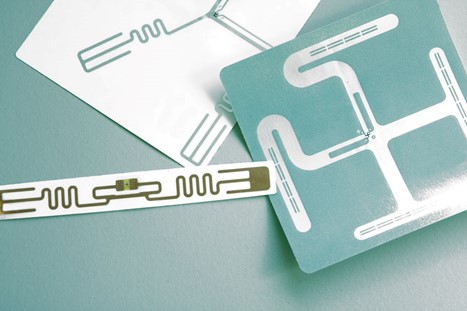What is conductive ink used for?

Conductive ink is an innovative technology that combines the convenience of ink with high-tech applications. It represents a whole new way to look at how pigment, dyes, and metallics can harmoniously work together to progress the way we think about what can be done with ink. There has been a lot of hype about how conductive ink may be used in the near future. But this article focuses on how it is being used in current applications.
What Is Conductive Ink?
Conductive ink is an exciting innovation that infuses pigmented ink with graphite or silver metal material. Those materials are natural conductors of electricity, and when added to ink, the ink takes on those same conductive properties. Once applied to a surface, the electricity can easily flow through the ink when it connects with an electrical source.Because ink is a liquid substance that has been used for ages for handwriting and printing, the possibilities for electrical conductivity ink are intriguing.
Low vs. High Resistance
One thing that may allow or hinder the use of conductive ink is its level of conductivity versus resistance. Some inks have low resistivity, and these inks are best used for achieving high frequency signals. Inks that produce a high level of resistance are best used for producing slow signals.Uses for Conductive Ink
As with any promising innovation, there are high hopes about what it can be used for, and conductive ink is no exception. So far, experimentation has provided some solid conductive ink uses for manufacturing in certain sectors. As of now, this ink is being used in the following ways.Paper Trace Circuits
One of the biggest uses of conductive ink is the creation of paper trace circuits. Anyone who knows how to create the lines of a circuit board can make one with paper and a conductive ink pen. After drawing a circuit design on a piece of paper using the ink, electrical sensors can be connected to the ink. It’s fun watching these sensors light up or do other things like create keyboard sounds.Paper trace circuits can be useful in teaching environments to demonstrate how electrical currents work. They can also be used for making circuit board prototypes. Some people use them to create cool, decorative artwork.
Rework and Repair Circuit Boards
For those who work with circuit boards, conductive ink is another useful tool to have on hand for rework and repairs. This isn’t surprising, considering that the ink is already being used for building some circuit boards. Professionals and hobbyists alike have quickly adapted its use, and the standard silver color ink is a perfect match for this kind of work.
RFID Tags
Makers of RFID tags have found ways to incorporate conductive ink into their products. RFID stands for “radio frequency identification”, and these tags are commonly used for any kind of tracking system that uses this technology to identify items. In some cases, the ink replaces other types of conductive metallic circuitry.E-Textiles
The use of conductive ink with textiles is still in its infancy. Some companies are experimenting with creating smart textiles, which are fabrics with conductive ink. The hope is that one day, people will be able to wear safe, conductive clothing. It may also be used one day for making accessories such as hats and bookbags.Rear Car Window Defogger
Many people have already seen conductive ink in use when they turn on their car’s defogger. Those silver lines painted on the vehicle’s rear window are often made with conductive ink.Tags
Q Source
Guest Blog
ESD
My Account
Web account
Transforming Technologies
bevco
guest blog
signs
wish lists
search history
Bevco
ANSI/ESD
importance of ergonomics
us made
healthy
ergonomics
easy assembly
q source
40
celebrates
blog tools
composite decking
decking
bench magnifier
vision engineering
vision luxo
file
attachments
upload
attach files
purchase order
tax exempt form
account holder
social distancing
employee safety
customer safety
metcal introducing gt90 and gt120
unitron
track orders
re-order
holiday
July 4th
office closure
Independence Day
QSource.com
wastebaskets
PCBs
ANSI/ESD S2020
workstations
conductive
static dissipative
Brady
arc flash
pipe markers
labels
lockout
tagout
self adhesive
identification
ASG
Jergens
torque
threaded fasteners
ISO 5393
NIST
35th
anniversary
1984
customer service
Q Electronics
Steve Quail
Gus Lugten
industrial assembly
production
miscellaneous
Web site
features
order templates
express checkout
quick order
company logos
Simonds
ergonomic tools
cutters
crimpers
pneumatic
Shopping Tools
favorites
frequent orders
checkout defaults
carts
Atrix
Omega
cordless vacuum
immediate containment
promo
ULPA
SMTA
Long Island
workshop
Deadly Sins of SMT
Phil Zarrow
assembly process
stereo microscope
On the Bench
how-to
focus
Unitron
Peter Indrigo
video
Z10 Series
eyestrain
ergonomic seating
musculoskeletal disorders
Department of Labor
National Research Council
National Safety Council
soldering
comic books
smt
surface mount technology
Mighty Ohm
Silicon Farmers
Mitch Altman
Andie Nordgren
Jeff Keyzer
Greg Peek
Dave Roberts
Nitrile
allergies
latex
rubber gloves
TechNiGlove
Fritz Maskrey
Type 4
disposable gloves
4500 Series
rubber table mats
free shipping
static control
order tracking
recent web orders
user info
shopping tools
account tools
backless stools
ErgoLux
ErgoLux Jr
Versa
Maintenance Repair
ANSI-BIFMA
Greenguard Gold
lab
medical
cleanroom
industrial
electronic assembly
quotes
orders
shopping
Quantum Storage Systems
Free Shipping
Bins
Totes
Carts
Shelving
Static Solutions
hand lotion
EOS/ESD
personal grounding
wrist straps
heel grounders
Craig Zander
Walking Voltage Test
flooring
footwear
Warmbier
WT5000
EFM51WT
web account
nitrile gloves
Show All
Posts
2024
April
2023
2022
2021
The Ultimate Guide to Selecting the Right Industrial Equipment for Your Business
[04/02/24 10:15 AM]
February
Bevco - Importance of Ergonomics in Seating
[02/27/24 11:27 AM]
The Bevco Difference
[02/22/24 02:52 PM]
January
October
September
2020
Magnifying Glass Strength and What it Means
[09/15/21 10:03 AM]
Steps on How to Desolder a Keyboard
[09/01/21 10:39 AM]
August
What Is the Best Conductive Ink Pen for 2021?
[08/18/21 10:58 AM]
Tips on How to Find and Where to Use ESD Floor Products
[08/10/21 02:39 PM]
Quick Guide: What Is a Dial Test Indicator Used For?
[08/04/21 12:00 AM]
July
What Is an SMD Rework Station and How Does it Work?
[07/28/21 02:25 PM]
Quick Guide: How to Use ESD Mats and Wrist Straps
[07/14/21 12:05 PM]
June
All About Static Shielding and Static-Shielding Bags
[06/30/21 12:42 PM]
Conductive Ink: 5 Conductive Ink Uses for Modern Industry
[06/16/21 10:42 PM]
Soldering 101: How Long Do Soldering Tips Last?
[06/02/21 02:39 PM]
May
Industrial Needles: How Do I Choose A Needle Gauge?
[05/20/21 08:43 AM]
Guide to the Best SMD Rework Stations of 2021
[05/05/21 12:10 PM]
March
November
2019
How to Wash Clean Room Garments
[11/12/20 12:00 AM]
The Smallest Hot Air Rework Station on the Market
[11/04/20 01:21 PM]
October
The Best Stereo and Zoom Microscopes Available Today
[10/29/20 08:51 AM]
Office Floor Marking Tape for Social Distancing
[10/21/20 02:41 AM]
Top 5 Uses for LED Magnifying Lamps
[10/15/20 12:22 AM]
August
How to Choose The Best Magnifying Task Lamp
[08/26/20 11:32 AM]
Helping the Pharmaceutical Industry
[08/19/20 09:26 AM]
Moisture Barrier Bags, Desiccant and Humidity Indicator Cards
[08/17/20 12:58 PM]
How Q Source Can Help The Electronic Industry
[08/12/20 02:25 PM]
Tips on How To Best Organize Your Warehouse
[08/05/20 09:39 AM]
July
Social Distancing Products for Businesses
[07/29/20 05:14 PM]
A Guide to Gloves
[07/22/20 09:01 AM]
How to choose the right ESD Bag
[07/21/20 12:02 AM]
When and How to Properly Use Face Masks
[07/15/20 02:23 PM]
What is Dwell Time? Tips for Disinfecting Surfaces
[07/09/20 05:49 AM]
June
MetCal -GT-90 and GT-120
[06/23/20 10:10 AM]
Defining ESD Protective Packaging Requirements
[06/22/20 10:28 AM]
Differences Between Cleaning, Sanitizing, & Disinfecting
[06/19/20 12:49 PM]
How to Maintain a Virus-Free Work Environment
[06/17/20 11:17 AM]
Ergonomic Safety & Microscopes: Unitron Offers a Solution
[06/01/20 04:11 PM]
April
March
Differences Between Brazing, Soldering, and Welding
[03/09/20 09:11 AM]
Guide to Soldering: How to Use a Soldering Iron
[03/06/20 04:00 PM]
Guide to Cleanroom Classifications & Standards
[03/06/20 11:26 AM]
How to Clean a Circuit Board - A Q Source Guide
[03/05/20 11:54 AM]
Electrostatic discharge -ESD
[03/04/20 05:34 PM]
Guide to ESD vs. Anti-Static Work Safety Wear
[03/04/20 05:00 PM]
How to Use Tip Tinner - 6 Easy Steps - Q Source
[03/04/20 09:11 AM]
January
December
October
2018
Vision-Engineering-Guest-Blog-Lean-Mfg
[10/14/19 02:42 PM]
Vision Engineering - Guest Blog - Stereo Microscope
[10/03/19 12:31 AM]
September
July
Managing Your Q Source Web Orders
[07/11/19 09:32 AM]
Celebrating the Red, White & (Q) Blue - Q Source Will Be Closed on July 4th & 5th in Honor of Independence Day
[07/03/19 12:55 PM]
June
ESD Wastebaskets: An Overlooked Necessity for Your Workstation Environment
[06/26/19 12:48 PM]
Signs, Signs, Everywhere There's Signs...and Labels, Ribbons & More
[06/21/19 10:54 AM]
A How-To for Determining Torque Requirements for Threaded Fasteners - Guest Blog
[06/18/19 04:20 PM]
Celebrating 35 Years of Providing Best Value and Better Service for Our Customers
[06/13/19 09:50 AM]
Q Source My Account Focus: Miscellaneous Web Site Features
[06/12/19 11:48 AM]
Q Source Adds Global Pneumatic Tools Leader Simonds Inc.'s Cutting & Crimping Products to Lineup
[06/04/19 05:19 PM]
Favorites, Wish Lists & More: A Closer Look at Your My Account Shopping Tools
[06/03/19 11:21 AM]
May
Get a Free Extra Battery w/Atrix' New Omega Cordless Immediate Containment Vacuum
[05/29/19 12:13 PM]
Long Island SMTA Workshop to Discuss the "Deadly Sins" of SMT
[05/28/19 11:22 AM]
How to Properly Focus a Stereo Microscope - "On the Bench" Series
[05/17/19 04:02 PM]
Ergonomic Seating: Good for the Body and the Wallet – Guest Blog
[05/16/19 12:06 PM]
Soldering Comic Books Bring How-To Knowledge to a Wide Audience
[05/14/19 10:19 AM]
Accelerator-Free Nitrile to the Rescue! TechNiGlove International's Fight Against Nitrile Allergy - Guest Blog
[05/09/19 11:16 AM]
April
Free Shipping on Select Transforming Technologies 4500 Series ESD Rubber Table Mats
[04/29/19 12:46 PM]
Learn How to Get the Most Out of Your Q Source Web Account
[04/29/19 09:54 AM]
Q Source's Mobile Apps for iOS and Android Devices
[04/18/19 10:21 AM]
Bevco Backless Stools: All-Around Reliability for a Variety of Applications
[04/09/19 01:07 PM]
Create Your Q Source Web Account Today: Discover the Great Features & Benefits
[04/09/19 10:35 AM]
March
Free Shipping on Quantum Storage Systems Products
[03/29/19 09:42 AM]
Static Solutions ESD Hand Lotions Help Fight Potential Static Damage - Guest Blog
[03/22/19 12:55 PM]
Is Your ESD Flooring and Footwear System Working? – Guest Blog
[03/20/19 12:55 PM]
Q Source Web Account Benefits & Features
[03/15/19 03:05 PM]
February


